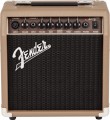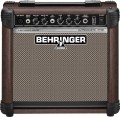Woofer size (LF/MF)
The diameter of the woofer or woofer installed in the combo amplifier. The specific value of this parameter may be different, depending on the number of lanes (see above). In three-way systems we are talking about bass dynamics, in two-way systems — about the dynamics responsible for low and medium frequencies; and if the amplifier does not have band separation, this paragraph indicates the diameter of the main radiator.
In general, the larger the radiator, the louder it can sound and the richer the bass from such a speaker is. At the same time, we note that the speaker diameter is selected by the manufacturer based on the power of the built-in amplifier and the expected sound volume. So the main indicator when choosing is still the rated power, and the size of the speaker is more of a reference value.
Effects
Built-in effects provided in the combo amplifier. You can also achieve various effects with the help of external “gadgets”, however, such gadgets need to be searched for and connected separately, while built-in effects are available immediately and without unnecessary settings.
—
Overdrive. Distortion in the form of a characteristic electric guitar "buzz" at low frequencies and "howl" at high frequencies, a little softer than distortion. Popular, in particular, in hard rock.
—
Distortion. Sufficiently hard and sharp distortion, similar in sound to overdrive, but more intense and brighter. It is widely used in various styles of metal, and is also found in rock.
—
Reverb. An effect based on simulating multiple decaying echoes from each sound. Depending on the duration and intensity of repetitions, it can give the sound a different colour. Used as an artistic device; among other things, it can create the effect that the guitar sounds in a certain room (concert hall, room with stone walls, an open area in the mountains, etc.). Note that the reverberation can be adjusted both by individual parameters (intensity, echo duration, etc.), and by selecting a preset set of parameters (for example, “sharp sound in the room” or “soft sound in the hall”).
—
Tremolo. Tremolo is basically a trembling effect that res
...ults from small and quick fluctuations in the volume of each note. Sometimes this term means vibrato (see below) — to the point that the manufacturers of guitar amplifiers themselves mean the effect of vibrato by the tremolo effect, and vice versa. So the specifics of this effect in each case should be clarified separately. Anyway, the tremolo can be "fixed" or adjustable in depth (range of volume change) and speed (jitter frequency).
— Vibrato. Another effect of "jerking" sound, which is often confused with tremolo (see above) — to the point that both these terms are used as identical. However, this is not true; the difference lies in the fact that vibrato is carried out due to the rapid fluctuations of the note not in volume, but in frequency. A similar effect can be achieved on the guitar itself by "pulsating" the strings, but using the amplifier's built-in instrument is much more convenient in most cases.
— Chorus. An effect designed to simulate the choral sound of an instrument. To do this, the amplifier copies the sound of the guitar and plays several copies simultaneously with the original signal, slightly shifting them in time (about 20 – 30 ms with a constant change) and frequency. However it is impossible to achieve a full-fledged choral sound in this way, but the effect is quite original in itself.
— Delay. A specific type of reverb (see "Reverb") that has become widespread as a separate effect. Delay simulates a clear single echo from the sound being played; for this, the original signal is copied and reproduced with a certain time delay (at least 50 ms).
In addition to those described above, other effects can be found in modern guitar combo amplifiers, in particular:
— Flanger. The effect is reminiscent of the whistle of a jet engine; it is often compared to a plane taking off. It is created similarly to the Chorus described above, differs from it in a shorter delay time and the presence of feedback.
— echo. Another kind of reverb, similar to delay (see “Delay”). It differs in that in this case the echo is reproduced repeatedly.
— Octaver. An effect in which a copy of it is added to the signal, shifted by an octave or two.
— Wah wah. An effect that produces a characteristic "croak" sound.Line input
The type of line input provided in the amplifier.
The line input is used to supply sound from an external source to a guitar amplifier (“amplifier” or “head”). In this case, the incoming audio signal is sent to the input of the power amplifier and through it to the built-in speaker or external cabinet. In any case, this function allows you to combine the “live” sound of the instrument with additional accompaniment: for example, you can connect a player with a recorded drum and bass part to the line input and learn the guitar part with accompaniment - or perform in a “one-man orchestra” format.
Different types of connectors can be used for line input:
— Mini-Jack (3.5 mm). A socket for a standard 3.5 mm mini-Jack plug. This interface is used mainly in portable audio equipment; Jack 6.35 mm and RCA are more popular in stationary devices.
— Jack (6.35 mm). A connector similar in design to the 3.5 mm mini-Jack and differing only in size. Actually, due to its size, this type of plug is practically never found in portable audio equipment, but is quite popular in stationary ones. Theoretically, a Jack type connector can be used for a balanced connection (see below), but in guitar combo amps a regular unbalanced input is more common.
- RCA. Connector for coaxial cable with tulip type plug. It is used exclusively in stationary audio equipment. A standard RCA input consists of two jacks (for
...stereo sound, left and right channel), but in guitar combo amplifiers there is only one connector, since there is no point in using stereo in this case - one channel is enough.
— Balanced XLR. The characteristic connector is round in shape with three contacts and is quite large in size. The term “balanced” describes the specifics of signal transmission: it is carried out not through two, as with a standard connection, but through three wires, two of which operate in antiphase. Due to this, most of the interference induced on the wire is extinguished by itself, without the use of any special filters, which allows the use of long cables without compromising signal quality. Balanced connections are found mainly in professional audio equipment. As with the RCA described above, the standard XLR input includes two jacks (stereo left and right), but guitar amps use a simplified, single jack version.
Some combo amplifiers are equipped with several types of line inputs at once - for example, Jack and RCA. This usually means having separate connectors for each type. Theoretically, multiple inputs allow you to simultaneously connect several signal sources, but in practice this possibility should be clarified separately.
